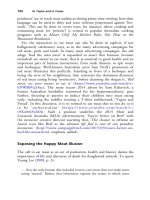The palgrave international handbook of a 242
Bạn đang xem bản rút gọn của tài liệu. Xem và tải ngay bản đầy đủ của tài liệu tại đây (33.3 KB, 1 trang )
International Trade in Animals and Animal Parts
237
expanded to include additional banned, regulated and monitored species,
divided among four Annexes (A, B, C, D) (EC 2010). However, this
approach is not shared with most EU member states. Disparities in the
enforcement and sanctioning levels among member states weaken the
responses of all member states. In recognition of the problems in the
enforcement of CITES, the EU has recently become party to CITES and
is currently developing an EU IWT Action Plan.
There are many limitations documented in terms of how effectively
CITES regulates the wildlife trade and deters IWT. Reeve (2002) suggests
CITES has been compromised by (a) being a self-policed system with no
global enforcement agency to oversee compliance, (b) the dissolution of
borders making the permit system irrelevant, and (c) chronic underfunding.
Additionally, both Yury Fedotov, the Director of the UNODC, and John E.
Scanlon, Secretary General of CITES, noted deficiencies in the official
response to organised offences, particularly with regard to legislation, law
enforcement, prosecution and punishment, criminal analysis and international cooperation (CITES 2013).
As the chief aim of CITES and related national legislation is to protect the
economic sustainability of the wildlife trade, trade is banned in only a few
critically endangered species, and the majority of wildlife are neither listed
nor protected (Sollund 2011). Non-CITES animals are an even lower
priority and thus even more vulnerable (Regueira and Bernard 2012) with
only minimal protection through generic animal welfare laws and transport
requirements. No specific legislation exists to provide international protection for the welfare of animals in the trade. As it stands, legislative protection
for wildlife from abuse is deficient. To send a clear message to poachers,
traders and consumers legislative changes are essential. Both the wildlife trade
and the related harms could be reduced through legislation which exerts
pressure on source countries to prevent, capture and remove the trade in
illegal products from local marketplaces, and on demand countries to
develop a clear message and response to reducing demand (Wyatt 2014).
Enforcement
Through monitoring only certain species and regulating, rather than banning, the wildlife trade, loopholes arise, creating opportunities for fraud and
corruption. Warchol et al. (2003), among others (Hubschle 2014; UNODC
2012; Wyatt 2009), have identified forgery, fraud and corruption in the









